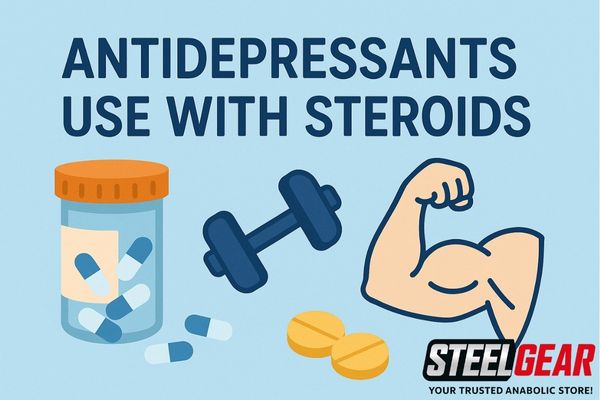The Complex Relationship Between Anabolic Steroids and Antidepressants
Introduction
Anabolic-androgenic steroids (AAS) are synthetic derivatives of testosterone commonly used to enhance physical performance, increase muscle mass, and improve body image. While initially developed for legitimate medical use, AAS are often misused, particularly in sports and bodybuilding. On the other side of the pharmacological spectrum, antidepressants are prescribed to treat various mood disorders, such as depression, anxiety, and PTSD. Although these drugs serve very different primary purposes, their interaction can be complex and significant—particularly when anabolic steroids contribute to or exacerbate mental health issues.

Anabolic Steroids and Mental Health
Anabolic steroids can have profound effects on the brain and emotional regulation. While users often report feelings of increased confidence, energy, and even euphoria during cycles, prolonged or heavy use can lead to serious psychological side effects. These may include:
Mood swings and irritability
Aggression and impulsivity ("roid rage")
Depression, especially during withdrawal
Anxiety and paranoia
Sleep disturbances
When anabolic steroid use is discontinued, many users experience a significant drop in mood—sometimes severe enough to meet the criteria for major depressive disorder (MDD). This is partially due to the suppression of the body’s natural testosterone production and the sudden imbalance in neurochemicals involved in mood regulation, such as dopamine and serotonin.
Antidepressants: Mechanism and Use
Antidepressants—such as selective serotonin reuptake inhibitors (SSRIs), serotonin-norepinephrine reuptake inhibitors (SNRIs), and tricyclic antidepressants—work by modulating levels of key neurotransmitters in the brain. These drugs aim to restore chemical balance, alleviating symptoms of depression and anxiety.
In the context of steroid-induced depression, physicians may prescribe antidepressants to manage the emotional fallout. However, treating depression caused by AAS use presents unique challenges.
The Interaction Between Anabolic Steroids and Antidepressants
Pharmacological Interactions
There are currently no widely reported direct chemical interactions between anabolic steroids and antidepressants. However, both classes of drugs impact neurotransmitter systems—particularly dopamine and serotonin—raising concerns about mood dysregulation and treatment resistance. In some cases, AAS use may blunt the effectiveness of antidepressants or lead to unpredictable mood responses.Masking and Misdiagnosis
Anabolic steroids can temporarily mask depressive symptoms due to their stimulating and euphoric effects. As a result, depression may go undiagnosed until the individual discontinues steroid use, at which point symptoms can resurface or worsen. This cycle complicates accurate diagnosis and treatment.Compliance Issues
Individuals using anabolic steroids illicitly may be reluctant to disclose this to healthcare providers, making it difficult for clinicians to properly assess the cause of depressive symptoms. This secrecy can hinder the effectiveness of antidepressant treatment and overall psychiatric care.
Treatment Considerations
When treating a patient who has used or is using anabolic steroids, clinicians must adopt a comprehensive and personalized approach. Key considerations include:
Full disclosure and trust between patient and provider
Monitoring hormonal levels, especially testosterone and cortisol
Potential use of hormone replacement therapy if natural testosterone remains suppressed
Close psychiatric evaluation during steroid withdrawal periods
Counseling or psychotherapy in combination with pharmacological treatment
Conclusion
The relationship between anabolic steroids and antidepressants is rooted in the complex interplay between brain chemistry, hormones, and behavior. While antidepressants can play a critical role in managing steroid-induced depression, their effectiveness may be limited unless the underlying issue of steroid use is also addressed. A multidisciplinary approach—encompassing medical, psychiatric, and psychological support—is essential to help individuals recover both physically and mentally.






















